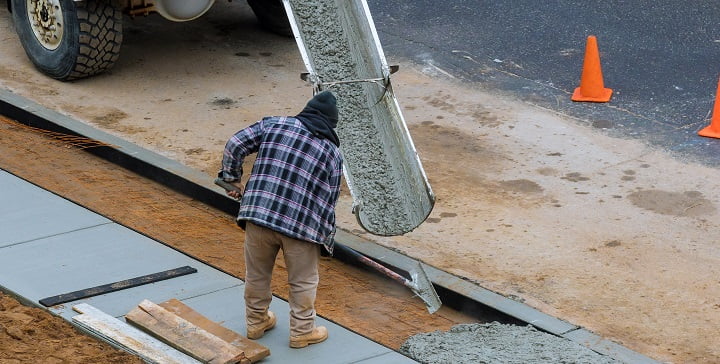A Guide to Building a Concrete Driveway
A Guide to Building a Concrete Driveway
- February 16, 2022
- Posted by: Mir Ready-mix Concrete
- Category: General Construction, Tips

Making the decision to purchase your first car is a significant step toward making your commute in a city like Dhaka more convenient. Unfortunately, your property does not have a driveway that would allow you to securely drive your car from the road to your garage. While many people devote a significant amount of effort and money to envisioning house designs and landscaping, the very important aspect of constructing a driveway is often overlooked. Aside from being the primary entry to your house, the driveway also serves as the primary load bearer for all of your car traffic. Even if you don’t know it, your driveway has a major impact on the initial impression of your house. The architectural style and size of your home are unquestionably key factors to consider while building a home. However, other aesthetic and practical choices, such as having a beautiful driveway to drive your car into your house, are also important considerations.
Checklist
Choosing RMC for Driveway Construction
When it comes to the kind of material to choose for your driveway, there are several options available. No homeowner, however, should overlook the importance of selecting the appropriate driveway material and ensuring that they are implemented properly. Asphalt, concrete, gravel, and bricks are the most often used materials. There are several variants within each group as well. Although your budget will play a role in determining the material, other technical and aesthetic aspects should also be taken into account.
Concrete driveways are generally considered to be the most durable of all the driveway materials available. Concrete is a mixture made up of many kinds of stone aggregates that are kept together with a combination of water and cement to form a strong and durable structure. Concrete is the most extensively used building material due to its high strength, long durability, broad range of uses, and high reflectivity. Ready-mix concrete is, without a doubt, the most dynamic technique of constructing any form of a building project. Using ready mix concrete to construct your driveway provides a comprehensive solution that saves time and money while also being environmentally responsible and giving greater quality and durability. Ready-mix concrete is the way to go if you want a simple, stress-free concrete option for your driveway construction project.

How to Lay a Concrete Driveway
A robust, luxurious, and long-lasting concrete driveway can only be achieved via adequate planning and patience. When it comes to installing a concrete driveway, there are many factors to consider. Let’s discuss the procedures involved in laying concrete to construct a suitable driveway for your home.
Calculating the dimension
Find out where your property’s boundaries are by doing some homework and inspecting the land blueprints. The dimensions of the driveway should be decided early on in the process. If you revise the measurements of the driveway at the eleventh hour, the strength and durability of your driveway will be affected.
Ordering ready mix concrete
Make sure you plan everything out in advance for the construction work so that you have clear deadlines to manage around. Given that the dimension of the driveway is determined, get in touch with mir ready mix concrete if you’re confused about how much concrete you’ll need for the driveway. Concrete from Mir Ready Mix Concrete is well suited to support the weight of personal vehicles, making it an excellent choice for driveways. Talk to us about how to give your order and set up a delivery time that works for you. You should leave enough time to prepare the ground before your concrete arrives.
Site preparation and Creating a solid foundation
To begin, outline your driveway’s border using wooden stakes and thread to mark the area to be concreted. The top layer must be cleaned of any obstructions, such as grass, stones, or other debris. Use herbicide to get rid of and prevent weeds from sprouting in the future. Excavate the topsoil to your required thickness to provide a durable and uniform foundation. Concrete slabs supporting driveways and garages, as a general rule, should be at least 100mm thick. Depending on the quality of the soil, you may need to dig down an additional 100mm, and then use crushed gravel or hardcore to cover the area. Be sure to compact and level out this layer throughout the whole area to provide a stable foundation for your concrete.
Laying a wooden form
Formwork is important for keeping the concrete in the appropriate areas throughout the pouring process and for achieving a polished look on the concrete driveway. The top of the formwork can be considered as a guide to maintaining the required slab thickness. As the formwork is being built, it’s critical that you take your time and double-check each dimension to ensure accuracy.
Slim wooden panels may be used to construct this temporary formwork structure. Place the panels straight and keep them well secured. In order to remove this barrier from the concrete later on without ruining the surface, it must be coated with a release agent before pouring the concrete into place.
Installing a reinforcement layer
Metal rebar (reinforcing bar) or steel wire grid are spread over the area in a criss-cross pattern directly above the compacted gravel foundation as a reinforcement layer. Using rebar can be very critical for any construction project. Because of the ridges, it is easier for the concrete to adhere to the surface of the rebar. It is possible to minimize the quantity of concrete required by integrating rebar into the structure to improve the strength of the concrete. Reinforcing your concrete ensures even distribution of the weight of the vehicles throughout the driveway, resulting in a significant increase in its structural integrity. Cracks and premature wear may be avoided by using this method. This will extend the life of your driveway and lower your overall maintenance costs.
Pouring the RMC
Just sit back and wait for the concrete to show up once the site has been set up. In order to prevent the concrete from drying out, it must be unloaded and balanced as soon as possible after arriving at your work site. There should be an adequate place for the delivery truck to park on the construction site. It is advisable to rent a concrete pump to pour your concrete rather than pouring it from the mixer or using wheelbarrows. Using a hoe or a shovel, uniformly spread the concrete from the farthest corner of the perimeter to the center. By a few centimeters, the concrete should overflow the top of the formwork. An edging trowel may be used to remove any extra concrete after it has been distributed uniformly.
Smooth out the surface
A shovel or leveler may be used to distribute the concrete between the formwork and gently flatten it to produce a uniform, smooth surface. Finally, a straight-edged piece of wood may be used to press the concrete down, removing any air pockets as well as guaranteeing complete coverage. The excess concrete may be used in shallow spots as you push ahead. Formwork that is flat and even should result in excellent surface quality.
Adding control joints
Control joints or grooves should also be installed over the wet surface at specific spacing. For a 100mm-thick concrete driveway slab, the maximum spacing should be 10 feet. The depth of the control joints should also be maintained. Placing them one-quarter of the slab thickness is advisable (or 25mm for a 100mm slab).
This prevents the concrete slab from cracking even if it settles and shifts slightly. A slab’s random cracking may be caused by natural settling and movement if it doesn’t have control joints. Despite the fact that random cracks are usually not structural issues and will not shorten the driveway’s lifespan, they may be an eyesore. Where the driveway meets a sidewalk or garage floor slab, an isolation joint should be placed in addition to control joints.
Applying broom finish
Slippery smooth concrete can be dangerous as they are quite slippery. Accidents are more likely to happen in smooth driveways while it’s raining. So texturing the surface to provide more traction to the driveway is always preferable. A broom can be used to draw lines to finish the concrete to improve traction. If not, you have alternative options for applying a beautiful textured finish. This will make your driveway ideal for wet conditions.
Curing
After all of the foregoing work has been completed, the curing phase of a concrete driveway installation begins. Curing concrete is an important step in the hardening and strengthening of the material. If the concrete isn’t properly cured, it can be weak and break down pretty easily. Consequently, it is essential that this curing process takes place under ideal conditions. Curing will take much longer in cold temperatures. Whereas, in order to slow down the curing period in hot weather, the surface should be sprayed with water on a frequent basis. Over the following ten to twelve days, you should cover the concrete with polythene and let it dry out naturally. The polythene will keep the concrete from drying out too rapidly, preventing cracks and other issues with the surface. In order to avoid any potential damage to the corners of the new slab while removing the formwork, it is recommended to wait 72 hours before doing so. It will take 28 days for the concrete driveway to achieve its final strength.
Summary
A concrete driveway is a wonderful choice for a variety of reasons. It is more durable than constructing a driveway with any other materials, and it requires little to no care over the long term. Furthermore, concrete may be colored and textured to produce a beautiful one-of-a-kind surface, significantly increasing the value and aesthetic appeal of your property.
F.A.Q.
What is the possibility of my driveway cracking in the future?
Ans: If you hire a trusted ready mix concrete supplier and do everything as planned (e.g., give ample time for curing), the occurrence of cracking is unlikely to happen.
Which is more durable, concrete or asphalt driveway?
Ans: Concrete, a proven construction material, will be undoubtedly more durable than building an asphalt driveway, lasting at least two or three times longer.
How long will a concrete driveway last?
Ans: Under proper maintenance, a concrete driveway is likely to last for almost 40-50 years.
Why should I hire a contractor for building my driveway than building myself?
Ans: Any concrete construction project requires skilled manpower, especially during the curing process. Hiring a contractor can eliminate the possibilities for mistakes and ensure excellence.
Where to find a proper concrete supplier in Bangladesh?
Ans: Mir Ready Mix, a leading ready mix concrete supplier in bd, promises to deliver the best quality ready mix complying with all relevant standards and specifications at customers’ doorknobs.
